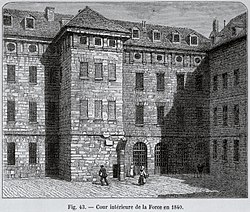La Force Prison

Inner court of La Force in 1840
|
|
| Coordinates | 48°51′20″N 2°21′20″E / 48.85556°N 2.35556°ECoordinates: 48°51′20″N 2°21′20″E / 48.85556°N 2.35556°E |
|---|---|
| Opened | 1780 |
| Closed | 1845 |
| Former name | Hôtel de la Force La Grande Force La Petite Force |
| Street address | Rue de Roi de Sicile |
| City | Paris |
| Country | France |
| Notable prisoners | |
|
Princesse de Lamballe Jean Sylvain Bailly Pierre-Jean de Béranger Constantin-François Chassebœuf Claude Fournier Pierre Choderlos de Laclos Victor Claude Alexandre Fanneau de Lahorie Claude Ledoux Pierre Victurnien Vergniaud |
|
La Force Prison was a French prison located in the Rue du Roi de Sicile, in what is now the 4th arrondissement of Paris. Originally known as the Hôtel de la Force, the buildings formed the private residence of Henri-Jacques Nompar de Caumont, duc de la Force. Towards the end of the reign of Louis XIV, the Hôtel de la Force was divided into two parts, one of which took the name of the Hôtel de Brienne, and had its entrance in the Rue Pavée; the other retained its former name and had its entrance in the Rue du Roi de Sicile.
After passing through several hands, the buildings were acquired, in 1754, by the war ministry, and were transformed, in 1780, into a prison. The Hôtel de la Force was renamed La Grande Force and was intended for debtors and those charged with civil offences. The prison consisted of several buildings, each of which had a separate yard. The most airy building was situated in the centre between two yards planted with trees. It was there that such prisoners were detained who could incur some expense. On the left was the infirmary.
At the same time the Hôtel de la Force was being converted into a prison, the Hôtel de Brienne was demolished, and a new prison for prostitutes was erected on its site, which was called La Petite Force. The front presented a sombre aspect. It was ornamented with vermiculated rustics and the entrance was formed by an elliptical arch. It was three storeys high and was surmounted by a Doric cornice. In its construction, neither wood nor plaster were employed, the whole being built of stone bound together by iron bars. It was located adjacent to the Hôtel de Lamoignon.
During the French Revolution, this prison was used for political prisoners, and it was here that the close friend of Marie Antoinette, the Princesse de Lamballe was taken. La Force came under attack by violent mobs on 3 September 1792, and the four following days:- one hundred and sixty prisoners, among whom were three priests and the Princesse de Lamballe, were massacred there.
...
Wikipedia
